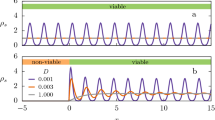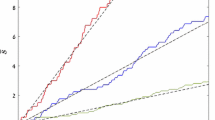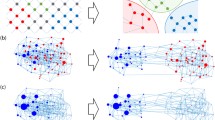Abstract
A Phenotypic Adaptive Landscape is defined with fitness as the ordinate, and longevity of the juvenile phase and duration of disturbances to the adult phase as the horizontal axes. The effect of local environmental perturbations on the landscape’s shape is studied using a semistochastic population model. In this model the intrinsic population dynamics takes the form of a differential-delay nonlinear equation and the environmental disturbance appears as a multiplicativetelegraphic noise. We demonstrate that the landscape has no single characteristic scale. Rather, it shows adaptive peaks corresponding to an integer relation between the biological and the environmental periodicities. Since the system is constrained by a finite time and a finite physiological range, the landscape may have different topographies for different local environmental regimes. A very simple fully deterministic model is presented, predicting landscapes that are similar to those obtained by the semistochastic model. Application to life history strategies are discussed.
Similar content being viewed by others
References
Agur Z 1983 Persistence in uncertain environments. InPopulation biology. Proceedings eds) H I Freedman and C Strobeck (Heidelberg: Springer Verlag) pp. 125–132
Agur Z 1985 Randomness, synchrony and population persistence.J. Theor. Biol. 112: 677–693
Agur Z and Deneubourg J L 1985 The effect of environmental disturbances of the dynamics of marine intertidal populations.Theor. Popul. Biol. 27: 75–90
Ben Leib L 1980 Introduction to theoretical ecology.Bull. Ecol. Soc. Am. 612: 38
Beverton R J H and Holt S J 1957On the dynamics of exploited fish populations (London: Her Majesty’s Stationery Office)
Dobzhansky T, Ayala F, Valentine J W and Stebbins G L 1977Evolution (San Francisco: W H Freeman and Co.)
Greenwood P J, Harvey P H and Slatkin M 1985 Introduction. InEvolution: Essays in honor of John Maynard Smith eds) P J Greenwood, F Ayala and M Slatkin (Cambridge: University Press) pp. vii-viii
Hutchinson E 1957 Concluding remarks.Cold Spring Harbor Symp. Quant. Biol. 22: 415–427
Lande R 1985 Expected time for random genetic drift of a population between stable phenotypic states.Proc. Natl. Acad. Sci. USA 82: 7641–7645
Levins R 1965Evolution in changing environments: Monographs in population biology 2 (Princeton: University Press)
Lewontin R C 1974The genetic basis of evolutionary change (Cambridge: University Press)
Martins P S and Jain S K 1979 Role of genetic variation in the colonization ability of the rose clover (Trifolium hirtum).Am. Nat. 107: 591–595
Newman C M, Cohen J E and Kipnis C 1985 Neo-Darwinian evolution implies punctuated equlibria.Nature (London) 315: 400–40
Oster G and Takahashi Y 1974 Models for age-specific interaction in a periodic environment.Ecol. Monogr, 44:483–501
Slobodkin L B 1968 Toward a predictive theory of evolution. InPopulation biology and evolution (ed.) R C Lewontin (Syracuse: University Press) pp. 187–205
Slobodkin L B 1986 The role of minimalism in art and science.Am. Nat. 127: 257–265
Slobodkin L B and Rapoport A 1974 An optimal strategy of evolution.Q. Rev. Biol. 49: 181–200
Wright S 1932 The role of mutation, inbreeding, crossbreeding, and selection in evolution.Proc. 6th Int. Congr. of Genetics (ed.) Donald F Jones (New York: Brooklyn Botanic Gardens) vol. 1, pp. 356–366
Wright S 1969Evolution and the genetics of populations (Chicago & London: University of Chicago Press) vol. 2, p. 472
Author information
Authors and Affiliations
Additional information
Publication no. 593, Program in Ecology & Evolution, SUNY Stony Brook.
Rights and permissions
About this article
Cite this article
Agur, Z., Slobodkin, L.B. Environmental fluctuations: How do they affect the topography of the adaptive landscape?. J. Genet. 65, 45–54 (1986). https://doi.org/10.1007/BF02923535
Received:
Issue Date:
DOI: https://doi.org/10.1007/BF02923535




